I haven't provided detailed commentary on the US labour market for a while now. To…
Australian labour force data – monthly blip or turning point?
Today’s release of the – Labour Force data – for February 2014 by the Australian Bureau of Statistics can be taken in one of two ways. Either the strong full-time employment growth and rising participation rate is a turning point and the economy is improving or the ABS will revise the data downwards and things won’t look so rosy next month. That is the problem of data that exhibits (at times) big monthly shifts that are not reliable. But let’s hope it is the data shift is signalling better times to come. Full-time employment jumped (suspiciously) by 80,500 thousand, the largest monthly change since August 1991 and in the months that followed things fell apart quickly. The participation rate rose by 0.2 points this month, which meant the employment growth was unable to prevent unemployment from rising. The unemployment rate rose (on rounded figures) to 6 per cent from 5.9 per cent and is 50 per cent above the previous low in February 2008. A month’s employment growth is a good thing but there is no cause for celebration. Monthly hours worked fell in February and taken together with the growth in full-time employment and the plunge in part-time employment, one could easily suspect that the high-end hours part-time jobs have been converted into full-time jobs (which is a good thing) but overall the labour force worked less. It remains that employment growth has been around zero for nearly two years and there is an upward bias in unemployment.
The summary ABS Labour Force (seasonally adjusted) estimates for February 2014 are:
- Employment increased 47,300 (0.6 per cent) with full-time employment increasing by 80,500 and part-time employment falling by 33,300.
- Unemployment increased by 9,800 (1.3 per cent) to 742,200.
- The official unemployment rate rose to 6.0 per cent (from 5.9 per cent).
- The participation rate rose by 0.2 percentage points to 64.8 but is well below its November 2010 peak (recent) of 65.9 per cent.
- Aggregate monthly hours worked decreased by 14 million hours (-0.86 per cent).
- The quarterly ABS broad labour underutilisation estimate (the sum of unemployment and underemployment) was published for the February-quarter in this month’s release and showed that underemployment fell by 0.2 percentage points to 7.4 per cent. The total labour underutilisation rate rose to 13.5 per cent in the February-quarter up from to 13.4 per cent in November. There were 903.9 thousand persons underemployed.
UPDATE: The ABS noted in this month’s results:
The incoming rotation group for February 2014 had a higher proportion of employed persons and persons in the labour force (i.e. less persons not in the labour force) than the sample it replaced. This incoming rotation group contributed, in original terms, 37% of the increase in total employment and 29% of the decrease in persons not in the labour force in February 2014. The trend estimates provide a better measure of the underlying level and direction of the series especially when there are significant rotation group effects.
Which means that employment growth and rise in the participation rate is not really as strong relative to last month as the data suggests. It also means that unemployment may have actually fallen (given the weaker participation impact).
Employment growth – positive with strong full-time growth
The February 2014 data shows that employment increased by 47,300 (close enough to 0.6 per cent) with full-time employment rising very strongly by 80,500 (suspiciously strong) and part-time employment decreased by 33,300.
Over the last 24 months or so we have seen the labour market data switching back and forth regularly between negative employment growth and positive growth spikes. This month’s figure, however, is the strongest overall performance in that time.
The following graph shows the month by month growth in full-time (blue columns), part-time (grey columns) and total employment (green line) for the 12 months to February 2014 using seasonally adjusted data.
Today’s results just repeat the topsy-turvy nature of the data over the period shown although there have now been two consecutive months of negative employment growth.
While full-time and part-time employment growth are fluctuating around the zero line, total employment growth is still well below the growth that was boosted by the fiscal-stimulus in the middle of 2010.
The following table provides an accounting summary of the labour market performance over the last six months. The monthly data is highly variable so this Table provides a longer view which allows for a better assessment of the trends. WAP is working age population (above 15 year olds).
The conclusion – overall there have 65.3 thousand jobs (net) added in Australia over the last six months – all due to this month’s figure. Full-time employment has fallen by 33.7 thousand jobs (net) while part-time work has risen by 31.6 thousand jobs.
The Working Age Population has risen by 189 thousand in the same period while the labour force has risen by 103.9 thousand. The participation rate has fallen substantially (0.1 percentage points) over the last six months.
This has had the effect of attenuating the rise in unemployment.
The weak employment growth has thus not been able to keep pace with the underlying population growth and unemployment has risen by 39 thousand as a result.
The rise in unemployment would have been worse had the participation rate not dropped.
Caution is needed in interperting today’s data. It may indicate a turning point in the economy towards better performance (especially the unusually strong full-time employment growth combined with the rise in participation). It may also be the case that the ABS will revise the data next month and things won’t seem as rosy. We cannot tell from today’s results.
To put the recent data in perspective, the following graph shows the movement in the labour force and total employment since the low-point unemployment rate month in the last cycle (February 2008) to February 2014. The two series are indexed to 100 at that month. The green line (right-axis) is the gap (plotted against the right-axis) between the two aggregates and measures the change in the unemployment rate since the low-point of the last cycle (when it stood at 4 per cent).
You can see that the labour force index has largely levelled off yet the divergence between it and employment growth has risen sharply (in spurts) over the last several months.
The Gap series gives you a good impression of the asymmetry in unemployment rate responses even when the economy experiences a mild downturn (such as the case in Australia). The unemployment rate jumps quickly but declines slowly.
It also highlights the fact that the recovery has not strong enough to bring the unemployment rate back down to its pre-crisis low. You can see clearly that the unemployment rate fell in late 2009 and then has hovered at the same level for some months before rising again over the last several months.
The Gap shows that the labour market is now in worse shape than it was at the peak of the financial crisis in 2009. After the government prematurely terminated the fiscal stimulus the situation has progressively deteriorated.
In fact, in February 2014, the Gap (2.4 percentage points) exceeded the levels that appeared in May and June 2009 when the Australian economy was enduring the impact of the crisis. All the gains made since then have thus disappeared due to poorly crafted fiscal policy not responding appropriately to non-government spending changes.
Full-time and Part-time employment in recovery
The following graph shows employment indexes for the last 3 recessions and allows us to see how the trajectory of total employment after each peak prior to the three major recessions in recent history: 1982, 1991 and 2009 (the latter to capture the current episode).
The peak is defined as the month of the low-point unemployment rate in the relevant cycle and total employment was indexed at 100 in each case and then indexed to that base for each of the months as the recession unfolded.
I have plotted the 3 episodes for 72 months after the low-point unemployment rate was reached in each cycle. The current episode is now in its 72th month.
The initial employment decline was similar for the 1982 and 1991 recessions but the 1991 recovery was delayed by many month and the return to growth much slower than the 1982 recession.
The current episode is distinguished by the lack of a major slump in total employment, which reflects the success of the large fiscal stimulus in 2008 and 2009.
However, the recovery spawned by the stimulus clearly dissipated once the fiscal position was reversed and the economy is now producing very subdued employment outcomes.
Moreover, the current episode is also different to the last two major recessions in the sense that the recovery is over and the economy is deteriorating again.
The next 3-panel graph decomposes the previous graph into full-time and part-time employment. The vertical scales are common to allow a comparison between the three episodes.
First, after the peak is reached, part-time employment continues to increase as firms convert full-time jobs into fractional jobs.
Second, recoveries are dominated by growth in part-time employment as firms are reluctant to commit to more permanent arrangements with workers while there is uncertainty of the future course in aggregate demand.
Third, the current recovery is clearly mediocre by comparison, with both very subdued growth in full-time and part-time work.
Teenage labour market – they didn’t participate in the growth
Full-time employment for teenagers fell by 7.7 thousand in February 2014 while part-time employment rose by 1 thousand. Overall, teenage employment fell by 6.7 thousand in February 2014. Given the strength of the full-time employment rise in this month, the fact that teenagers went backward is deeply disturbing.
The following graph shows the distribution of net employment creation in the last month by full-time/part-time status and age/gender category (15-19 year olds and the rest)
If you take a longer view you see how poor the situation is.
Over the last 12 months, teenagers have lost 18.5 thousand jobs while the rest of the labour force have gained 88.3 thousand net jobs. Remember that the overall result represents a very poor annual growth in employment.
Even more disturbing is the attrition of full-time jobs among teenagers – losing 15.5 thousand over the last year.
The teenage segment of the labour market is being particularly dragged down by the sluggish employment growth, which is hardly surprising given that the least experienced and/or most disadvantaged (those with disabilities etc) are rationed to the back of the queue by the employers.
The following graph shows the change in aggregates over the last 12 months.
To further emphasise the plight of our teenagers, I compiled the following graph that extends the time period from the February 2008, which was the month when the unemployment rate was at its low point in the last cycle, to the present month (February 2014). So it includes the period of downturn and then the so-called “recovery” period. Note the change in vertical scale compared to the previous two graphs.
Since February 2008, there have been only 884.2 thousand (net) jobs added to the Australian economy but teenagers have lost a staggering 107 thousand over the same period. It is even more stark when you consider that 104.6 thousand full-time teenager jobs have been lost in net terms.
Even in the traditionally, concentrated teenage segment – part-time employment, 2.4 thousand jobs (net) have been lost even though 474.4 thousand part-time jobs have been added overall.
Overall, the total employment increase is modest. Further, around 54 per cent of the total (net) jobs added since February 2008 have been part-time, which raises questions about the quality of work that is being generated overall.
To put the teenage employment situation in a scale context the following graph shows the Employment-Population ratios for males, females and total 15-19 year olds since February 2008 (the month which coincided with the low-point unemployment rate of the last cycle).
You can interpret this graph as depicting the loss of employment relative to the underlying population of each cohort. We would expect (at least) that this ratio should be constant if not rising somewhat (depending on school participation rates).
The facts are that the absolute loss of jobs reported above is depicting a disastrous situation for our teenagers. Males, in particular, have lost out severely as a result of the economy being deliberately stifled by austerity policy positions.
The male ratio has fallen by 10.7 percentage points since February 2008, the female by 6.1 percentage points and the overall teenage employment-population ratio has fallen by 8.4 percentage points.
Overall, the performance of the teenage labour market continues to be deeply disturbing. It doesn’t rate much priority in the policy debate, which is surprising given that this is our future workforce in an ageing population. Future productivity growth will determine whether the ageing population enjoys a higher standard of living than now or goes backwards.
The longer-run consequences of this teenage “lock out” will be very damaging.
The problem is that in the modest growth period that the Australian labour market enjoyed as a result of the fiscal stimulus and mining investment, teenagers failed to participate in the gains – they went backwards.
Now, with the economy entering a new period of slowdown, these losses will be added too given that teenagers are among the first in line to be shown the door by employers seeking to reduce staff levels in the face of declining aggregate sales.
The previous Government’s response was to push this cohort into endless training initiatives (supply-side approach) without significant benefits. The research shows overwhelmingly that job-specific skills development should be done within a paid-work environment.
I would recommend that the new Australian government immediately announce a major public sector job creation program aimed at employing all the unemployed 15-19 year olds, who are not in full-time education or a credible apprenticeship program.
It is clear that the Australian labour market continues to fail our 15-19 year olds. At a time when we keep emphasising the future challenges facing the nation in terms of an ageing population and rising dependency ratios the economy still fails to provide enough work (and on-the-job experience) for our teenagers who are our future workforce.
Unemployment – rises sharply
The unemployment rate increased to 6 per cent in February 2014, up from 5.9 per cent in January. Official unemployment increased by 19,800 (1.3 per cent) to 742,200.
Overall, the labour market still has significant excess capacity available in most areas and what growth there is is not making any major inroads into the idle pools of labour.
The following graph updates my 3-recessions graph which depicts how quickly the unemployment rose in Australia during each of the three major recessions in recent history: 1982, 1991 and 2009 (the latter to capture the 2008-2010 episode). The unemployment rate was indexed at 100 at its lowest rate before the recession in each case (January 1981; January 1989; April 2008, respectively) and then indexed to that base for each of the months as the recession unfolded.
I have plotted the 3 episodes for 72 months after the low-point unemployment rate was reached in each cycle. The current episode is now in its 72th month (0 being February 2008). For 1991, the peak unemployment which was achieved some 38 months after the downturn began and the resulting recovery was painfully slow. While the 1982 recession was severe the economy and the labour market was recovering by the 26th month. The pace of recovery for the 1982 once it began was faster than the recovery in the current period.
It is significant that the current situation while significantly less severe than the previous recessions is dragging on which is a reflection of the lack of private spending growth and declining public spending growth.
Moreover, the current episode is also different to the last two major recessions in the sense that the recovery is over and the economy is deteriorating again.
The graph provides a graphical depiction of the speed at which the recession unfolded (which tells you something about each episode) and the length of time that the labour market deteriorated (expressed in terms of the unemployment rate).
From the start of the downturn to the 72-month point (to February 2014), the official unemployment rate has risen from a base index value of 100 to a value 150 – the previous peak being 147.5 after 17 months. After falling steadily as the fiscal stimulus pushed growth along (it reached 122.8 after 35 months – in January 2010), it has been slowly trending up for some months now. Unlike the other episodes, the current trend, at this stage of the cycle, is upwards.
It is now above the peak that was reached just before the introduction of the fiscal stimulus. In other words, the gains that emerged in the recovery as a result of the fiscal stimulus in 2009-10 have now been lost.
At 72 months, 1982 index stood at 148.1 (and falling) while the 1991 index was at 141.4 (and falling). It is clear that at an equivalent point in the “recovery cycle” the current period is more sluggish than our recent two major downturns and trending upwards while the trend in the earlier episodes was moderately downwards.
It now appears that the recoveries have converging, which tells us that the current policy has failed to take advantage of the fact that the latest economic downturn was much more mild than the previous recessions. In other words, the policy failure is locking the economy into a higher unemployment rate than is desirable and otherwise attainable.
Note that these are index numbers and only tell us about the speed of decay rather than levels of unemployment. Clearly the 5.8 per cent at this stage of the downturn is lower that the unemployment rate was in the previous recessions at a comparable point in the cycle although we have to consider the broader measures of labour underutilisation (which include underemployment) before we draw any clear conclusions.
The notable aspect of the current situation is that the recovery is very slow.
Broad labour underutilisation
The ABS published its quarterly broad labour underutilisation measures in this data release.
In the February-quarter, total underemployment fell by 0.2 percentage points to 7.4 per cent and the ABS broad labour underutilisation rate rose by 0.1 points to 13.5 per cent (the sum of unemployment and underemployment).
| There were 903.9 thousand persons underemployed. Overall, there are 1.65 million workers either unemployed or underemployed. |
The following graph plots the history of underemployment in Australia since February 1978.
If hidden unemployment is added to the broad ABS figure the best-case (conservative) scenario would see a underutilisation rate well above 15 per cent at present. Please read my blog – Australian labour underutilisation rate is at least 13.4 per cent – for more discussion on this point.<
The following graph shows the same type of indexes as the previous graph except it uses the ABS broad labour underutilisation rate (unemployment plus underemployment). It also is in terms of quarters rather than months.
We also show the full evolution of the the 1982 and 1991 episodes from the low-point (= 100) through the peak and back to the next low-point. In the case of the 1982 recession the index had risen to a peak of 172.8 in May 1983 (a broad underutilisation rate of 14.4 per cent) and then fell back to 9.8 per cent by November 1989 (index value 117.4).
At that point, the cycle turned down again signalling the beginning of the 1991 recession. That cycle reached a peak of 185 (or 18.1 per cent in November 1992) and it took until February 2008 for it to reach the low-point of 9.9 percent (an index value of 100.9). That point marked the beginning of the next cycle.
That should tell you how severe the 1991 recession was and how asymmetric the labour market response is on either side of the cycle. From its start in November 1989 it took 74 quarters (18.5 years) to return to more or less that level.
In terms of the three recession comparison, at the same period in the recovery (using quarterly data), the broad labour underutilisation rate (unemployment plus underemployment) had an index value of 147 in the 1982 recession (absolute value of 10.5 per cent); an index value of 154.4 in the 1991 recession (absolute value of 15.1 per cent); and an index value of 136.76 in the current period (absolute value of 13.5 per cent).
So while the level of unemployment is much lower now than in the 1982 recession (at a comparable stage), underemployment is now much higher and so the total labour underutilisation rates is higher. Further, the 1982 recovery in broad underutilisation terms was more robust than the current stagnating situation.
Commentators who think of the 1982 recession as severe, rarely see it in these terms. Joblessness is probably worse than underemployment but both mean that labour is wasted and income earning opportunities are being foregone. For a worker with extensive nominal commitments, the loss of income when hours are rationed may be no less severe than the loss of hours involved in unemployment, if the threshold of solvency is breached.
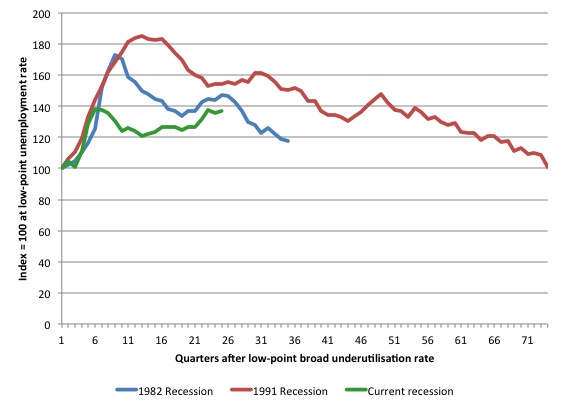
The next update will be in the May Labour Force data release.
Aggregate participation rate – rises
The February 2014 participation rate rose by 0.2 points to 64.8 per cent. It remains substantially down on the most recent peak in November 2010 of 65.9 per cent when the labour market was still recovering courtesy of the fiscal stimulus.
Total unemployment would have falling this month if the participation rate had not have risen. Whether the combination of rising full-time employment and a rising participation rate will be sustained remains to be seen. This looks suspiciously like an aberrant monthly blip, but then it could also be a turning point. We will see.
But what would the unemployment rate be if the participation rate was at that November 2010 peak level?
The following graph tells us what would have happened if the participation rate had been constant over the period November 2010 to February 2014. The blue line is the official unemployment since its most recent low-point of 4 per cent in February 2008.
The red line starts at November 2010 (the peak participation month). It is computed by adding the workers that left the labour force as employment growth faltered (and the participation rate fell) back into the labour force and assuming they would have been unemployed. At present, this cohort is likely to comprise a component of the hidden unemployed (or discouraged workers).
Total official unemployment in February 2014 was estimated to be 742.2 thousand. However, if participation had not have fallen since November 2010, there would be 931.6 thousand workers unemployed given growth in population and employment since November 2010.
| The unemployment rate would now be 7.5 per cent if the participation had not fallen below its November 2010 peak of 65.9 per cent. |
The difference between the two numbers mostly reflects the change in hidden unemployment (discouraged workers) since November 2010. These workers would take a job immediately if offered one but have given up looking because there are not enough jobs and as a consequence the ABS classifies them as being Not in the Labour Force.
Note, the gap between the blue and red lines doesn’t sum to total hidden unemployment unless November 2010 was a full employment peak, which it clearly was not. The interpretation of the gap is that it shows the extra hidden unemployed since that time.
As the participation rate dropped over the period, the gap rose.
This is quite a different picture to that portrayed by the official summary statistics.
Hours worked – fall in February 2014
Aggregate monthly hours worked rose by 14 million hours (-0.86 per cent) in seasonally adjusted terms. The fall in hours worked confirms a bias towards decline rather than sustained growth.
The following graph shows the trend and seasonally adjusted aggregate hours worked indexed to 100 at the peak in February 2008 (which was the low-point unemployment rate in the previous cycle).
The next graph shows the monthly growth (in per cent) over the last 24 months. The dark linear line is a simple regression trend of the monthly change – which depicts a slightly downward trend. You can see the pattern of the change in working hours is also portrayed in the employment graph – zig-zagging across the zero growth line.
Conclusion
In general, we always have to be careful interpreting month to month movements given the way the Labour Force Survey is constructed and implemented.
If we didn’t exercise caution we would conclude from today’s data shows that the Australian labour market is much stronger than it has been with both full-time employment and participation rates rising. That combination is usually a good sign – more hours on offer and peope coming in from the hidden unemployment pools outside the labour force as job prospects rise.
But given the monthly variability we need to exercise caution. It is hoped the this month’s data represents a turning point but that conclusion is not concrete or based on other current trends in the economy.
It is just as likely that the previous stagnant state of the labour market with employment growth continuing to lag behind population growth will reassert itself in the coming months and the ABS will revise this month’s data down.
With that said, the broad labour underutilisation rate rose to 13.5 per cent and monthly hours worked fell. So conflicting signs given the full-time employment bounce.
But what cannot be understated or uncertain is the continuing appalling performance of the teenage labour market. Employment has collapsed for that cohort since 2008. I consider it a matter of policy urgency for the Government to introduce an employment guarantee to ensure we do not continue undermining our potential workforce.
This month, teenagers lost further full-time and part-time work – so even if today’s data sticks – teenagers didn’t participate in the growth.
The data certainly shows that the new government has to reverse the contractionary bias and that means only one thing – more fiscal stimulus is definitely needed.
It is time for the conservatives to abandon their free market/anti-government biases and do some public sector job creation, which will arrest the current decline and stimulate private sector activity and employment!
However, at least one politician will claim in the next week or so that we are near full employment and the government deficit needs to be cut. That is the appalling state that we find ourselves in.
That is enough for today!
(c) Copyright 2013 Bill Mitchell. All Rights Reserved.
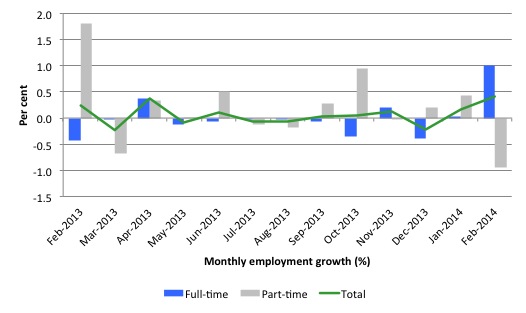
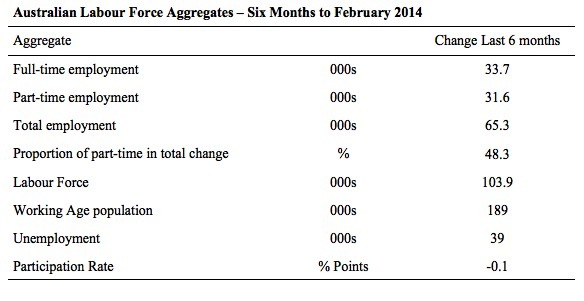
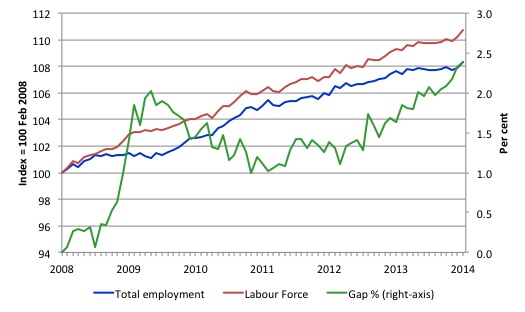
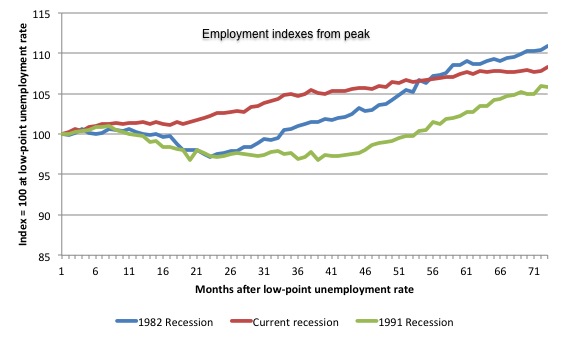

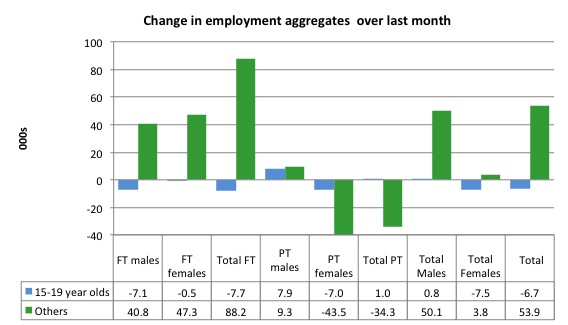
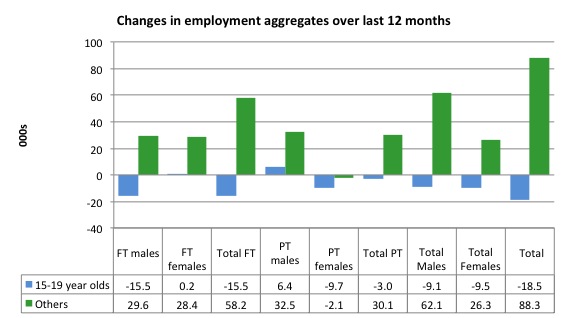
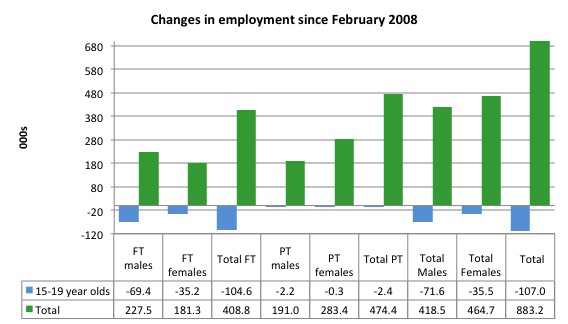
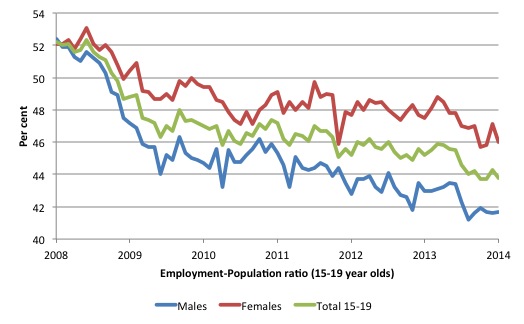
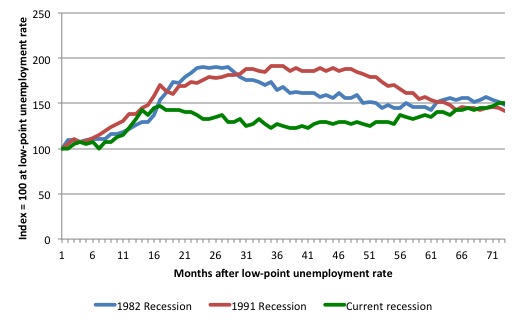
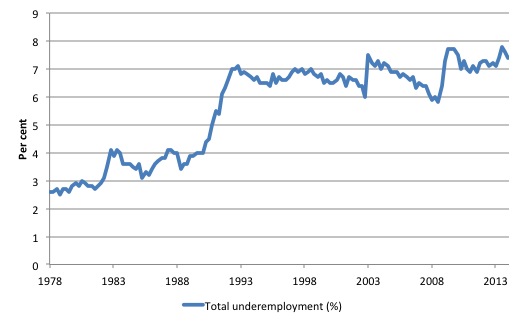
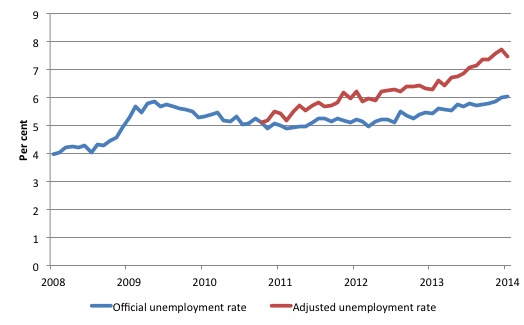
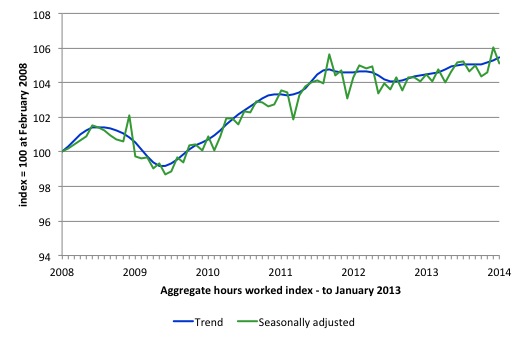
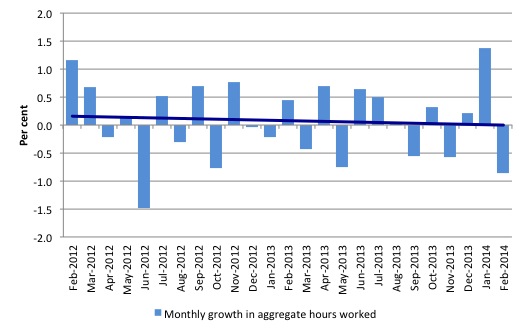
The ABS are already mentioning sample rotation as the cause of a significant part of the growth http://www.macrobusiness.com.au/2014/03/abs-undermines-strong-labour-data/#comment-335647